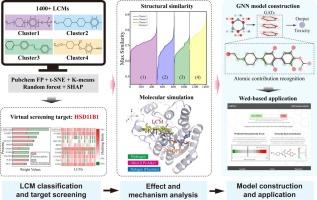Machine learning-accelerated determination of immunotoxicities of liquid crystal monomers
IF 11.3
1区 环境科学与生态学
Q1 ENGINEERING, ENVIRONMENTAL
引用次数: 0
Abstract
Liquid crystal monomers (LCMs), essential components of liquid crystal displays (LCDs), have emerged as a growing global concern because of their potential adverse effects on human health. However, experimental evidence elucidating their toxicological mechanisms remains scarce. In this study, a novel mode-of-action (MOA)-based graph neural network (GNN) framework was introduced to (1) identify the molecular initiating event (MIE) through which LCMs disrupt immune homeostasis, (2) predict their binding affinity to 11β-hydroxysteroid dehydrogenase type 1 (HSD11B1), and (3) identify toxicity-relevant substructures to guide the molecular design of safer LCMs. First, an unsupervised clustering approach was applied to categorize over 1,400 LCMs into four structural clusters. Then, two virtual screening methods (i.e., 2D/3D structural similarity analysis and a pharmacophore-based model) were applied to identify 121 possible receptors that could interact by potential insertions of LCM with a total universe of approximately 2,000 human protein receptors. Through “fingerprint”-based, t-distributed stochastic neighbor embedding (t-SNE) and molecular similarity analysis using PubChem, LCMs were found to be potential inhibitors of HSD11B1. Third, docking simulations revealed that highly fluorinated and ester-containing monomers exhibit stronger binding affinities at the HSD11B1 active site, primarily through stable hydrogen bonding. Finally, a GNN model was developed, which accurately predicted LCM-HSD11B1 binding affinities (R2 = 0.90, RMSE = 2.36) and identified key structural features contributing to immunotoxicity. Furthermore, a user-friendly, web-based prediction tool was developed to facilitate broader applications. These findings reveal HSD11B1 as a novel MIE of LCM-induced immunotoxicity and provide a practical immunotoxicity prediction platform to support risk assessment and the design of environmentally friendly LCM alternatives in LCD manufacturing.

液晶单体免疫毒性的机器学习加速测定
液晶单体(lcd单体)是液晶显示器(lcd)的重要组成部分,由于其对人类健康的潜在不利影响而日益受到全球关注。然而,阐明其毒理学机制的实验证据仍然很少。在本研究中,引入了一种新的基于MOA的图神经网络(GNN)框架来(1)识别lcm破坏免疫稳态的分子启动事件(MIE),(2)预测它们与11β-羟基类固醇脱氢酶1型(HSD11B1)的结合亲和力,(3)识别毒性相关的亚结构,以指导更安全的lcm的分子设计。首先,采用无监督聚类方法将1400多个lcm分为4个结构聚类。然后,应用两种虚拟筛选方法(即2D/3D结构相似性分析和基于药物团的模型)鉴定了121种可能通过LCM的潜在插入与大约2000个人类蛋白质受体相互作用的受体。通过基于“指纹图谱”的t分布随机邻居嵌入(t-SNE)和PubChem的分子相似性分析,发现lcm是HSD11B1的潜在抑制剂。第三,对接模拟显示,高氟化和含酯单体在HSD11B1活性位点表现出更强的结合亲和力,主要是通过稳定的氢键。最后,建立了GNN模型,该模型准确预测了LCM-HSD11B1的结合亲和力(R2 = 0.90, RMSE = 2.36),并确定了与免疫毒性相关的关键结构特征。此外,还开发了一个用户友好的基于网络的预测工具,以促进更广泛的应用。这些发现表明HSD11B1是LCM诱导免疫毒性的新MIE,并为支持LCD制造中LCM的风险评估和环保替代品的设计提供了实用的免疫毒性预测平台。
本文章由计算机程序翻译,如有差异,请以英文原文为准。
求助全文
约1分钟内获得全文
求助全文
来源期刊

Journal of Hazardous Materials
工程技术-工程:环境
CiteScore
25.40
自引率
5.90%
发文量
3059
审稿时长
58 days
期刊介绍:
The Journal of Hazardous Materials serves as a global platform for promoting cutting-edge research in the field of Environmental Science and Engineering. Our publication features a wide range of articles, including full-length research papers, review articles, and perspectives, with the aim of enhancing our understanding of the dangers and risks associated with various materials concerning public health and the environment. It is important to note that the term "environmental contaminants" refers specifically to substances that pose hazardous effects through contamination, while excluding those that do not have such impacts on the environment or human health. Moreover, we emphasize the distinction between wastes and hazardous materials in order to provide further clarity on the scope of the journal. We have a keen interest in exploring specific compounds and microbial agents that have adverse effects on the environment.
 求助内容:
求助内容: 应助结果提醒方式:
应助结果提醒方式:


